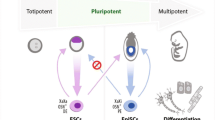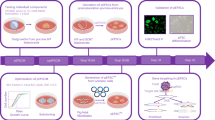Abstract
Pig induced pluripotent stem cells (piPSCs) offer a great opportunity and a number of advantages in the generation of transgenic animals. These immortalized cells can undergo multiple rounds of genetic modifications (e.g., gene knock-in, knockout) and selection leading to animals that have optimized traits of biomedical or agricultural interests. In this chapter we describe the production and characterization of piPSCs, microinjection of piPSCs into embryos, embryo transfer and production of chimeric animals based on successful protocols.
Access this chapter
Tax calculation will be finalised at checkout
Purchases are for personal use only
Similar content being viewed by others
References
West FD, Uhl EW, Liu Y, Stowe H et al (2011) Chimeric pigs produced from induced pluripotent stem cells demonstrate germline transmission and no evidence of tumor formation in young pigs. Stem Cells 29:1640–1643
West FD, Terlouw SL, Kwon DJ, Mumaw JL et al (2010) Porcine induced pluripotent stem cells produce chimeric offspring. Stem Cells Dev 19:1211–1220
Ezashi T, Telugu BP, Alexenko AP et al (2009) Derivation of induced pluripotent stem cells from pig somatic cells. Proc Natl Acad Sci U S A 106:10993–10998
Esteban MA, Xu J, Yang J, Peng M et al (2009) Generation of induced pluripotent stem cell lines from Tibetan miniature pig. J Biol Chem 284:17634–17640
Fujishiro SH, Nakano K, Mizukami Y, Azami T et al (2013) Generation of naive-like porcine-induced pluripotent stem cells capable of contributing to embryonic and fetal development. Stem Cells Dev 22:473–482
Takahashi K, Tanabe K, Ohnuki M, Narita M et al (2007) Induction of pluripotent stem cells from adult human fibroblasts by defined factors. Cell 131:861–872
Okita K, Ichisaka T, Yamanaka S (2007) Generation of germline-competent induced pluripotent stem cells. Nature 448:313–317
Takahashi K, Yamanaka S (2006) Induction of pluripotent stem cells from mouse embryonic and adult fibroblast cultures by defined factors. Cell 126:663–676
Wu Z, Chen J, Ren J, Bao L et al (2009) Generation of pig-induced pluripotent stem cells with a drug-inducible system. J Mol Cell Biol 1:46–54
Yang JY, Mumaw JL, Liu Y et al (2012) SSEA4 positive pig induced pluripotent stem cells are primed for differentiation into neural cells. Cell Transplant 22:945–959
Zhou L, Wang W, Liu Y, Fernandez de Castro J et al (2011) Differentiation of induced pluripotent stem cells of swine into rod photoreceptors and their integration into the retina. Stem Cells 29:972–980
Mountzouris KC, Tsitrsikos P, Palamidi I, Arvaniti A et al (2010) Effects of probiotic inclusion levels in broiler nutrition on growth performance, nutrient digestibility, plasma immunoglobulins, and cecal microflora composition. Poult Sci 89:58–67
Mitalipova MM, Rao RR, Hoyer DM, Johnson JA et al (2005) Preserving the genetic integrity of human embryonic stem cells. Nat Biotechnol 23:19–20
Acknowledgement
This work was supported by the Georgia Research Alliance Endowment and the University of Georgia Research Foundation.
Author information
Authors and Affiliations
Corresponding author
Editor information
Editors and Affiliations
Rights and permissions
Copyright information
© 2015 Springer Science+Business Media New York
About this protocol
Cite this protocol
West, F.D., Terlouw, S.L., Dobrinsky, J.R., Lu, Y., Jordan, E.T., Stice, S.L. (2015). Generation of Chimeras from Porcine Induced Pluripotent Stem Cells. In: Verma, P., Sumer, H. (eds) Cell Reprogramming. Methods in Molecular Biology, vol 1330. Humana Press, New York, NY. https://doi.org/10.1007/978-1-4939-2848-4_14
Download citation
DOI: https://doi.org/10.1007/978-1-4939-2848-4_14
Publisher Name: Humana Press, New York, NY
Print ISBN: 978-1-4939-2847-7
Online ISBN: 978-1-4939-2848-4
eBook Packages: Springer Protocols




